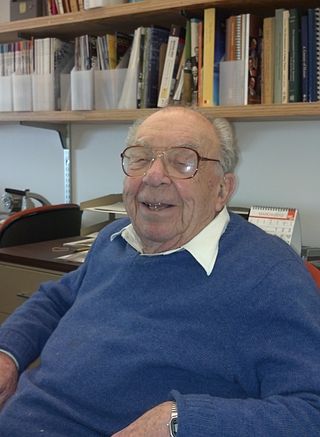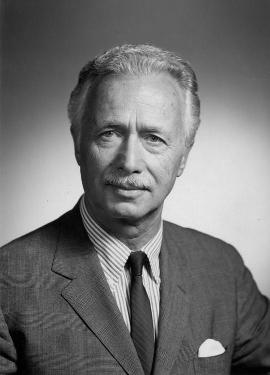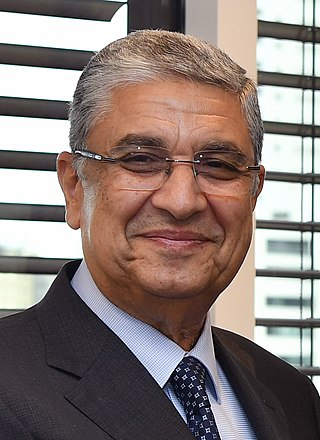
Electrical engineering is an engineering discipline concerned with the study, design, and application of equipment, devices, and systems which use electricity, electronics, and electromagnetism. It emerged as an identifiable occupation in the latter half of the 19th century after the commercialization of the electric telegraph, the telephone, and electrical power generation, distribution, and use.

Sir John Ambrose Fleming FRS was an English electrical engineer and physicist who invented the first thermionic valve or vacuum tube, designed the radio transmitter with which the first transatlantic radio transmission was made, and also established the right-hand rule used in physics.

William Edwards Deming was an American business theorist, composer, economist, industrial engineer, management consultant, statistician, and writer. Educated initially as an electrical engineer and later specializing in mathematical physics, he helped develop the sampling techniques still used by the United States Census Bureau and the Bureau of Labor Statistics. He is also known as the father of the quality movement and was hugely influential in post-WWII Japan, credited with revolutionizing Japan's industry and making it one of the most dominant economies in the world. He is best known for his theories of management.

The Bonneville Power Administration (BPA) is an American federal agency operating in the Pacific Northwest. BPA was created by an act of Congress in 1937 to market electric power from the Bonneville Dam located on the Columbia River and to construct facilities necessary to transmit that power. Congress has since designated Bonneville to be the marketing agent for power from all of the federally owned hydroelectric projects in the Pacific Northwest. Bonneville is one of four regional Federal power marketing agencies within the U.S. Department of Energy (DOE).

Roberto Mario "Robert" Fano was an Italian-American computer scientist and professor of electrical engineering and computer science at the Massachusetts Institute of Technology. He became a student and working lab partner to Claude Shannon, whom he admired zealously and assisted in the early years of Information Theory.

Robert Gray Gallager is an American electrical engineer known for his work on information theory and communications networks.

Pietro Belluschi was an Italian-American architect. A leading figure in modern architecture, he was responsible for the design of over 1,000 buildings.
Paul Edward Gray was the 14th president of the Massachusetts Institute of Technology. He is known for his accomplishments in promoting engineering education, practice, and leadership at MIT and in the world at large.
Ernst Adolph Guillemin was an American electrical engineer and computer scientist at the Massachusetts Institute of Technology who spent his career extending the art and science of linear network analysis and synthesis. His nephew Victor Guillemin is a math professor at MIT, his nephew Robert Charles Guillemin was a sidewalk artist, his great-niece Karen Guillemin is a biology professor at the University of Oregon, and his granddaughter Mary Elizabeth Meyerand is a Medical Physics Professor at the University of Wisconsin-Madison.

Benjamin Garver Lamme was an American electrical engineer and chief engineer at Westinghouse, where he was responsible for the design of electrical power machines. Lamme created an efficient induction motor from Nikola Tesla's patents and went on to design the giant Niagara Falls generators and motors and the power plant of the Manhattan Elevated Railway in New York City.
Reinhold Rudenberg was a German-American electrical engineer and inventor, credited with many innovations in the electric power and related fields. Aside from improvements in electric power equipment, especially large alternating current generators, among others were the electrostatic-lens electron microscope, carrier-current communications on power lines, a form of phased array radar, an explanation of power blackouts, preferred number series, and the number prefix "Giga-".
Abraham H. Haddad is an Israeli control theorist and the Henry and Isabelle Dever Professor in the Department of Electrical and Computer Engineering, Northwestern University, Evanston, Illinois, United States. Haddad is known for his contributions to the theory of hybrid systems.
Otto Walter Heinrich Oscar Brune undertook some key investigations into network synthesis at the Massachusetts Institute of Technology (MIT) where he graduated in 1929. His doctoral thesis was supervised by Wilhelm Cauer and Ernst Guillemin, who the latter ascribed to Brune the laying of "the mathematical foundation for modern realization theory".
Microwave engineering pertains to the study and design of microwave circuits, components, and systems. Fundamental principles are applied to analysis, design and measurement techniques in this field. The short wavelengths involved distinguish this discipline from electronic engineering. This is because there are different interactions with circuits, transmissions and propagation characteristics at microwave frequencies.

Julian Jakub Bussgang was a Polish-American mathematician, businessman and author. He was most known for publishing the Bussgang theorem and for his work in the field of Applied Physics and communications. He published several technical papers and held six patents.

Mohamed Shaker El-Markabi is an Egyptian engineer and government official. He was chosen by Engineer Ibrahim Mahlab minister to take over the Ministry of Electricity and Renewable Energy. He is Mohamed Hamed Shaker El-Markabi Professor of Electrical Power Engineering at the Faculty of Engineering, Cairo University.
Louis Dijour Smullin was an American electrical engineer who spend most of his career at the Massachusetts Institute of Technology (MIT). He is best known for his work with Giorgio Fiocco to measure the distance to the Moon using a ruby laser in 1962, shortly after that device was invented. Earlier, he had worked in the microwave radar field at the MIT Radiation Laboratory and was instrumental in creating the Lincoln Laboratory that carried on this work. Later he worked on developing instrumentation for nuclear fusion research and many other projects. He retired in 1986 but worked in the department until 2001.
Thomas H. Lee was a Chinese-American electrical engineer and writer. He worked for General Electric for 30 years, where he developed the first practical vacuum interrupter and the silicon rectifier in the 1960s. In the 1980s he served as the Philip Sporn Professor of Energy Processing at the Massachusetts Institute of Technology and co-chaired the MIT Sloan School's Management of Technology program. He was elected a member of the National Academy of Engineering in 1975 and a foreign member of the Chinese Academy of Engineering in 2000. He was an IEEE Fellow and received the IEEE Haraden Pratt Award in 1983.
Marija D. Ilić is a Serbian-American electrical engineer known for her work on the control and pricing of large electrical power systems. She is a professor emerita of electrical and computer engineering at Carnegie Mellon University, a senior research scientist at the Laboratory for Information & Decision Systems at the Massachusetts Institute of Technology, a senior staff member at the MIT Lincoln Laboratory, and the founding chief scientist of New Electricity Transmission Software in Massachusetts.
Arthur Bernard Baggeroer is an American Electrical Engineer and emeritus Ford Professor of Engineering in the Departments of Mechanical Engineering and Electrical Engineering & Computer Science at the Massachusetts Institute of Technology.









